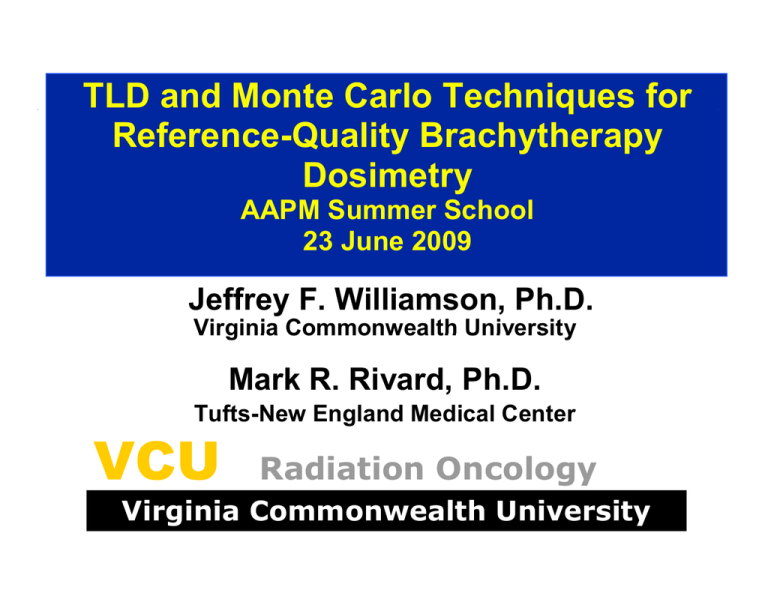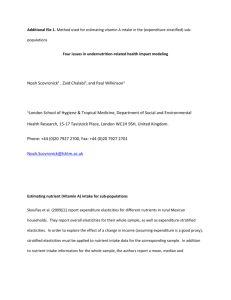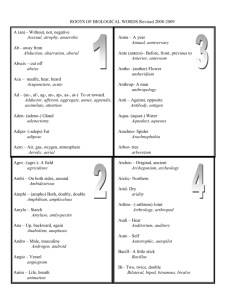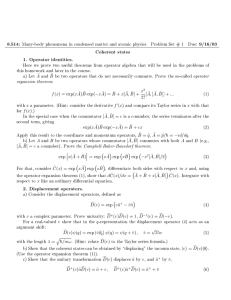Monte Carlo an nd Experimental Dosimetry of Low-energy
advertisement

TLD and Monte Ca
arlo Techniques
q
for
Monte Carlo an
nd
Reference-Qualit
ty Experimental
Brachytherapy
Dosimetry
ofmetry
Low-energy
Low
energy
Dosim
AAPM Sum
mmer
Brachythera
apy School
Sources
23 Jun
ne 2009
Jeffrey
F.
Wi
illiamson,
Ph.D.
Jeffrey F. Willliamson, Ph.D.
Virginia Common
nwealth University
Mark R. Riv
vard, Ph.D.
T ft N
Tufts-New
E
Englan
l nd
d Medical
M di l Center
C t
VCU
Radiatio
on Oncology
gy
Virginia Commonw
wealth University
Learning Ob
bjectives
• To review the requirements
s and challenges of
quantitative brachytherapy dosimetry
– Detector selection
– Roles of experimental and co
omputational dosimetry
• T
To review
i
the
th formalism,
f
li
te
t chniques,
h i
and
d associated
i t d
uncertainties of
– current TLD dosimetry practices
– Current Monte Carlo simulation dose-estimation practices
• To review emerging developments
– Improved energy-response corrections for TLD-100
– New detector systems
– Model-based
Model based dose
dose-calculatio
calculation algorithms
Potential COI Disclosures
• Williamson
– Research grants
supported by Varian
and Philips
• Rivard
– Research
R
h grants
t
supported by Nucletron,
Varian,, and IsoRay
y
(Radiumhemmet, Stockholm: 1945)
What is “Quantitattive Dosimetry?”
y
• Williamson’s definition: absorbed
a
dose estimation
method providing
– Accurate representation of well-defined physical quality
– Rigorous uncertainty analy
ysis <10% uncertainty 0
0.5
5 to
5 cm in liquid water
– Traceable to NIST primary standards
s
(SK,N99)
• Applications
– Single-source dose-rate arrrays for TG-43 parameter
d t
determination
i ti (“Reference
(“R f
quality”
lit ” dose
d
distributions)
di t ib ti
)
– Direct treatment planning
– Validating semi-empirical a
algorithms
Single-Source Do
ose Distributions
S
Superposit
ittion
ti Model
M d l
r
Isodoses
100 cGy/h
50
20
10
7
5
3
1
0.5
Single-source
Si
l
d
dose
distribution
di ib i
= Dosimetry
uperposition of multiple source doses
Su
= Treatment Planning
Criteria for experim
mental dosimeters
• Dosimetric environment
– Large Dose Gradients
– Wide Range of Dose Rates
– Low Photon Energies
• Signal stability and reprod
ducibility
– Spatially and temporally constant Sensitivity (signal/dose)
– Free of fading
fading, dose-rate
dose rate efffects
• Small size, high sensitivity
y, large dynamic range
– Small size: avoid averaging dose gradients
– Large size: Good signal at low doses
• ±20 m positioning accura
acy needed for 2% accuracy
• Support measurements att many points
Solid Water Phantom
ms for TLD Dosimetry
Transverse Axis Measurement Phantom
Polar Dose Profile Measurement Phantom
90
120
135
160
180
o
o
o
o
60
o
45
o
20
o
100-200 m positional ac
ccuracy achievable
0
o
o
TLD De
etectors
• Use TLD-100 LiF extruded ribbons (‘chips’)
1 x 1 x 1 mm3 at distances 2 cm
3 x 3 x 0.9 mm3 at distances 2 cm
• Use RMI 453 Machined So
olid Water Phantom
– Composition (CaCO3 + orga
anic foam) not stable
– Either p
perform chemical ass
say
y or use high
g purity
p
y PMMA
• Annealing protocol
1 hour 400°
400 C followed by 24
4 hours of 80
80° C pre-irradiation
pre irradiation
OR
1 hour 400° C pre-irradiation followed by
y 10 minutes at 100°
C Post-irradiation
Brachytherap
py Dosimetry
Detector
at (x,y,z)
Source
Gexp
Solid Water Phantom
Dose rate to
Water at (x,y,z)
Gref
Liquid Water Reference Sphere
• Giv
ven: M(r) = dosimeter (TLD or
Dio
ode) reading in geometry Gexp
• Des
sired: D med (r) S K absorbed
dos
se rate to water in reference
geo
g
ometry,
y, Gref
• Man
ny Corrections
– Detector
D
sensitivity
– Phantom
P
vs reference geometry
– Radiation
R
field Perturbation
– Detector
D
response artifacts
Experimental Dos
se Measurement-I
(r)
D
M kl (M) g(T) pphant (r)
med
rel
S
S
S
(M
)
S
K
K
AD
0
AD (r)
M(r) kl (M M0 ) g(T) pphant (Q exp ,Gexp Qref ,Gref ;r)
SK S AD (M0 ,Q 0 ,G0 ) S (Q 0 ,G0 Q exp ,Gexp ,r)
re
el
A
AD
• M = reading at position r in geo
ometry Gexp and spectrum Qexp
• SK = Measured Air-Kerma Sttrength
rl T
• g(T)
(T) = decay
d
correction
ti
over integration
t
ti interval,
i t
• Kl(M) = linearity correction rela
ative to reference level, M0
• SAD = M0/Dmed0 = absorbed dose
e sensitivity in calibration
beam with geometry G0 and sp
pectrum, Q0
Experimental Dos
se Measurement-II
(r)
D
med
SK
M kl (M) g(T) pphant (r)
SK S AD (M0 ) Srel
AD (r)
• Relative absorbed dose sens
sitivity: corrects for impact of
G0/Q0 vs.
vs Gexp/Qexp differences
s on dosimeter response
S (Q0 ,G0 Qexp ,Gexp ,r)
rel
AD
SAD,wat (r,M0 ,Qexp ,Gexp )
SAD,med0 (M0 ,Q0 ,G0 )
• Phantom correction factor: impact of Gexp/Qexp vs.
vs Greff/Qreff
differences on dosimeter response
Dwat (r,Qref ,Gref )
pphant,wat (Qexp ,G
Gexp Qref ,G
Gref ;r)
Dwat (r,Qexp ,Gexp )
TLD rea
adings
n
(T
TLi TLbkgd )
i1
Si
M(r)
( ) 1/ n
• TLi is
i Measured
M
d Respon
R
nse off ii-th
th detector
d t t att r
• Si is relative sensitivity of ii-th
th detector derived
osed to uniform doses
from reading TLDs expo
• TG-43 recommends n = 5-15
Relative Enerrgy Response
E(Q 0 ,G0 Qref ,Gref ,r;Gexp )
Srel
AD (Q 0 ,G0 Q exp ,Gexp ,r)
pphant,wat (Q exp ,Gexp Qref ,Gref ;r)
k (Q 0 Q exp ;M0 ) f (Q 0 ,G0 Q exp ,Gexp ,r)
rel
bq
rel
pphant
Gexp Qreff ,Greff ;r)
h t (Q exp ,G
• Absorbed dose energy dependence
d
Ddet Dwat (r,Q
(r Q exp ,G
Gexp )
f(r,Q
f(r
Q 0 ,G
G0 )
f (Q 0 ,G0 Q exp ,Gexp ,r)
f(r,Q exp
Ddet Dmed0 (Q 0 ,G0 )
e ,Gexp )
rel
• Relative intrinsic energy
y dependence
k (Q 0 Q exp ;M0 )
rel
bq
kbq (M0 ,Q
Q0 )
kbq (M0 ,Q
Q exp
M D (r,Q ,G
)
M D (Q ,G )
0
d t
det
0
exp
det
0
exp
0
)
Estimation
st at o o
of Energy
e gy-Response
espo se Co
Corrections
ect o s
• Theoretical Approximation
EThy (r;Gexp )
f rel (Q 0 , G0 Q exp ,G
Gexp ,r))
pphant (Q expp ,Gexp Qref ,Gref ;r)
assuming k (Q 0 Q exp
e ;M0 ) 1
rel
bq
• Direct measurement: x-ray
y beam
b
with spectrum
p
QFS Qexp
Emeas (r;Gexp )
SK,air (M0 ,Q exp ,G
, FS )
S AD,med0 (M0 ,Q
Q 0 ,G
G0 )
K
air
Dwaat (QFS ,GFS )
pdisp (r,Gexp ) p VolAvg (r,Gexp ) pphant,wat (Gexp Gref ;Q exp ,r)
Com
mpare detector to “matched”
X ray
X-ray
y Beam calibration in Free
Free-Air
Air
QFS 40-120 kVp
SK,air (QFSS ) M QFS ,GFS KFS
air
air
en /
(QFS )
SK,air (QFS )
wat
E(r)
S AD (Q 0 ) p VolAvg pdisp (r) pdisp
ed ion chamber
pdisp ((GFS
Scintillator Detector
D wat in mediu
um
Gexp )
0.97
FS
K wat iin cavit
ity
Dwat (r) Dwatt (r) at point r
p VolAvg (Q exp ,G
Gexp )
1
(0 80 1
1.00)
00)
(0.80
Dwat (r) V Dwat (r ')dV '
V(r )
Measured TLD-100 rela
ative Energy Response
Relattive Enerrgy Resp
ponse
1.5
Best fit line
Reft 1988
Muench
ue c 1991
99
Hartmann 1983
Weaver 1984
Meigooni 1988b
1.4
1.3
– Dolan (2006) in water
medium
di
– 6711 125I
• Emeas = 1.39-1.44
1 39-1 44 for 125I
12
1.2
– 1980-1990 in-air
measurements
1.1
• Conclusion:
1.0
0.9
1
10
• Ethy(1 cm) = 1.42
2
10
3
10
Photon energy (KeV)
EThy Emeas
krel
bq (4 MV
125
I) 1
• Conventional choice: E =1.4
=
w/o regard to details
• 2004 TG-43 U1 has assign
ned 5% uncertainty to E
Monte Carlo vs. TLD
T
Dose Rates
125
S
14 Models and 25 comparisons
I Seeds:
0 979 0
0.045
045 (1 cm)
0.979
MC
C
TLD
D
1.002 0.066 (5 cm)
103
d Seeds: 5 Models and 10 comparisons
Pd
0 982 0
0.028
028 (1 cm))
0.982
MC
C
TLD
D
1.045 0.106 (5 cm)
Modern Measurem
ments: kbg 1
1.15
Davis (2003) 3x3
3x0.4 mm
Das (1996) 3x3x
x0.9 mm
3
3
Nunn (2008) 3x3
3x0.8 mm
krel
bq (Q 0 Q)
3
1.10
det
Relative Intrinsic Energy
y Dependen
nce
(TL/D )
Nunn 2008, Davis 200
03, and Das 1995
Srel
K,air (Q 0 ,Gfs Q,Gfs )
fKrel (Q 0 ,G
Gfs Q,G
Q Gfs )
1.05
Nunn-Davis Results
1.00
0.95
k
10
100
1
1000
rell
bq
1.09-1.10
1.10 2% 23 keV
1.09
1.08-1.11 2% 32 keV
Photon Energy (keV)
Energy linearity of TLD
D is controversial
Impact of krel Revisions on
o MC-TLD Agreement
• Rivard comparisons of TLD and MC at 1 cm and 5 cm
for 125I and 103Pd sources
• Revised krel > 1.05 will sig
gnificantly worsen agreement
M
Monte
Carlo/TLD dose rate
Source
125
Distance
Krel
bq 1.00
rel
rel
K
1.075
K
Krel
1.05
bq
bq 1.10
bq
1 cm
0.979 ± 0.045
1.028
1.052
1.077
5 cm
1 002 ± 0
1.002
0.066
066
1 052
1.052
1 077
1.077
1 102
1.102
1 cm
0.982 ± 0.028
1.031
1.056
1.080
5 cm
1.045 ± 0.106
1.097
1.123
1.150
I
103
Pd
Relative Ene
ergy Respon
nse: E(d)
Absorbed Dose Energy
y Response Correction
1.45
I--125 Seed Ethy
h (d) in Solid Water
1.35
Patel, Chiu-Tsao, Williamson 2001
1.25
1.15
LiF Point Detector
1x1x1 mm TLD-100
Chemical Analysis: 1.6%
% Ca
RMI Specifications: 2.3% Ca {
1.05
0
1
2
3
3
1x1x1 mm TLD-100
3
4
5
Dis
stance (cm), d
• Ethy is not a constant
– 4% variation with distance even in water
– Displacement correction 4% fo
or 1 mm mini-cubes
• Solid-to-Liquid Water correction: 4%-15% at 1-5 cm
– 10-30% variations in SW [Ca] rep
ported 5%-20% dosimetric errors
Absorbed Dose Energy
y Response Correction
Relative E (1 cm, fo
or Model 6711
125
thy
I Source
Dolan et al. Med. Phys. 2006
o
E (1 cm, )/E (1 cm, 90 )
1.25
1.20
PMMA: Point
P
P
PMMA:
Volume
L
Liquid
water: Point
L
Liquid
water: Volume
S
Solid
water: Point
S
Solid
water: Volume
thy
thy
y
1.15
1.10
1.05
1.00
0 95
0.95
0
10
20
30
40
50
60
70
80
90
Polar Angle (Degrees)
• Up to 22% variation in E(r,) with polar angle
TLD uncertainties:
(r) / S
D
wat
K
for Model 6711 125I in PMMA
1 cm distance
5 cm distance
Component
% x
i
Type
% x
Type
i
TLD reading statistics
1.3%
A
2.2%
A
TLD calibration ((including
g Linac calibration))
1.8%
A+B
1.8%
A+B
f rel (Q 0 Q exp ,r) and pphant (Gexp Gref ,r)
0.7%
B
1%
B
Seed/TLD positioning (d = 100 m)
1.2%
B
0.2%
B
krel
b (Q 0 Q exp )
bq
5%
B
5%
B
NIST SK + one local transfer
1%
B
1%
B
Combined std. uncertainty (k = 1)
5.7%
5.9%
M
Monte
C
Carlo
l uncertainties:
i i
M d l 6711
Model
6 11 seed
d iin liquid
li id water
Distance
1 cm
5 cm
10 cm
Statistics
0.2%
0.3%
0.7%
Photon cross-sections
0.7%
2.4%
4.1%
Seed geometry
1.1%
0.9%
0.8%
Source energy spectrum
0.2%
0.3%
0.5%
Combined std. uncertainty (k =1)
1.3%
2.6%
4.3%
Adapted from Dolan et al. Med Phys 2006
Other dosime
etry
y systems
y
• Single element detectors
– High sensitivity, small size,, good SNR, and waterproof
– Plastic scintillator
» Used as transfer/relative dosimeters for beta sources
» Large (30%) energy nonlinearity
– Diode: underutilized in pre
esenter’s opinion
» Energy linearity well esttablished
» Large E(d) variation for medium energy sources
» Established as relative d
dosimeter for low-energy
low energy
• 2D/3D dosimetry media
– Radiochromic film and poly
ymer gels
– Improved positional accura
acy and spatial resolution
R
Radiochromic
Film
• Le an
nd Williamson 2006
– MD
D-55-2 RCF with LDR 137Cs source
– 6 day
d exposure
– Un
Uncertainty
t i t (k = 1) < 3
3.4%
4% ffor D
D>5
5G
Gy,
0.1
1 mm spatial resolution, doubleexp
posure technique
– Ag
greement with MC 3%
• Chiu-Tsao
Tsao 2008
– EB
BT RCF with Model 3500 125I seed
– 0.6
6 to 279 h exposures
p
– Re
elative dose mapping (k=1)
uncertainty 4% at 0.2 mm spatial
res
solution
– Go
ood agreement with TG-43
Summary:
y TLD p
ph
hantom dosimetry
y
• 1-3 mm size precision: 2-5%
2
above 1 cGy
• Energy response correctio
ons
– Distance independent, exclud
ding phantom corrections
– Value of kbq is controversial ((<10%)
– Highly approximate frel values
s are routinely used
• Widely
Widely-used
used SW phantom h
has uncertain composition
– High-purity industrial plastics
s recommended
• Extensive benchmarking off TLD vs Monte Carlo
– 2-10% agreement for Pd-103 and I-125 sources
– 6%-10% absolute dose measurement uncertainty
Basic Discrete Event Monte
M
Carlo Algorithm
Randomly select
Location, direction
& energy
gy of p
primary
y
photon
select distance to
next collision
Select type of
collision
Photon
Collision
Select type of
collision
Hetero
ogeneity
Ag core
Ti capsule
I-125 Seed
Scoring
Bin, V
Select Energy and
angle
g of photon
p
leaving collision
Score collision’s
dose contribution
Collisional Physics Re
equirements for LowE
Energy
Brac
B chytherapy
h th
• Only photon transport needed
– Secondary CPE obtains (Dos
se Kerma)
– Neutral-particle variance red
duction techniques useful
• Comprehensive model of photon
p
collisions
– NIST EXCOM or EPDL97 Cro
oss sections are essential!!
– Coherent scattering and elec
ctron binding corrections
» Use molecular/condensed
d medium form factors
– Characteristic x-ray emission from photo effect
• Options: MCNP, EGSnrc, VCU’s
V
PTRAN_CCG,
GEANT, Penelope
6711 silver rod end
Electron microscopy
Geometric Model
Validation
DraxImage I-125 Seed
6711 contact radiographs
Contact
Radiograph
Final Model
Calculation of TG
G-43 Parameters
by MCPT
M
MCPT calculates per disinttegration within source:
- Dose to medium, Dmed(r), near
n
source in phantom
geometry: usually 30 cm liq
quid water sphere
- Air-kerma strength, SK, in free-air
f
geometry usually
5 m air sphere or detailed model
m
of calibration vault
Dwat (r 1 cm
m, / 2)
SK
Dwat ((r, / 2)) G(1
( cm, / 2))
g(r)
Dwat (1 cm, / 2) G(r, / 2)
Analog
g and Trackleng
gth Dose Estimation
g
Need cubic array of voxels:
1x1
1x1 mm3 to 2x2x2 mm3
S 1,4
,4
S 1
Analo
ogue Estimator (EGS method)
j=1
rn+1
2
(n+1,E
En+1)
3
4
rn
D2,3
2 3 from n+1
Energy in - Energy out
voxel mass
Expec
cted Value Tracklength Estimator
(n,En)
D1,4
1 4 from n En
s1,4
voxel volume
en
250 mm diameter
153mm Long
Wide-angle
g Free
Air Chamber
80mm
150mm
m
300mm
Source
0.08 mm Al filter
1 mm thick
tungsten collimator
V
V/2
NIST Primary Standard
interstitial sources
photons < 50 keV
0 (Gu
uard
Ring)
SK,99N
11 mm lo
ong,
250 mm ID
I
electrode
e
(I153 I11 )d2
(W / e)) k i
air (V153 V11 )
i
Kerma at a Point: Next
N
Flight Estimator
(r1,1,E 1,W1 )
(r0 ,0 ,E 0 ,W0 )
Photon
Collision
0,E
E0
1,E1
n,r ' ,En,r '
2,E 2Heterogeneity
core
AgAgcore
r3
Ti capsule
I-125 Seed
3,E 3
r
|r ' rn |
e
D(r ')) from n p n,r ' En,r ' ( en / )
| r rn |2
Calculatio
on of SK
E t
Extrapolated
l t d Poin
P int-Kerma
tK
method
th d
• Place sealed source model at
a center of large air sphere
• Calculate air-kerma/disintegration, Kair(d), as function
transverse axis distance, d
free-space
space ge
eometry by curve fitting
• Extrapolate to free
2
d
K air (d) d S K (1 d) e
Where SK and are unk
knowns
(1 + d) - SPR accounts ffor scatter buildup
= primary photon atten
nuation coefficient
Next-Flight Estim
mator Application
Use point dose at center
of 60 m x 3 mm Si active
volume to approximate D
Scanditronix Electron Field Diode
Monte Carlo Model
Li & Williamson
Williamson, PMB 1993
1
kbg (d)
D(d)
DNF (d)
M(d)
MC M(d) MC
Monte Carlo quantities and estimators
for typical seed
s
study
Dwat (cGy/simulated photon):
Transverse axis
angular dose profiles
Next-flight estimator for all distances
Track-length
Track
length estimator for RTP
R
voxel grid
Eab Energy imparted to WAFA
AC volume/simulated photon
Track length estimator wheen fluence varies over detector
Track-length
Next-flight point dose estim
mator for TLD/diode detectors
> 2 ccm from
o source
sou ce
Transverse-axis
K air at geometric points
in free air
angula
ar fluence profile (30 cm)
Track length for WAFAC
a
distribution
Next-flight for transverse axis
Models 200 (103Pd), 6702 (125I) and 6711 (125I) Seeds
• Model 200
0.826
0.612
0.800
0.700
0 560
0.560
0.80
00
0.70
00
0.890
0.50
00
– 103Pd distributed in
thin (2-25 m) Pd
metal coating of right
circular graphite
cylinder
li d
– 125I distributed on
surface of radio
transparent resin
spheres
3.000
3.500
4.500
0.600
3.500
2.200
4.500
4.500
3.140
1.090
0
• Model 6702
0.510
• Model 6711
Pb marker
Graphite pellet
Ti Capsule
Resin spheres
Ag Rod
R
Ag-h
halide layer
– 125I distributed in thin
((3
m)) silver-halide
coating of right
circular Ag cylinder
Sharp corners and
d opaque coatings
Thin Highdensity coating
Low-density
core
Near transverse-axis:
Anisotropic at long distances
I t
Isotropic
i att short
h t distances
di t
Inverse square-law deviations
Anisotropic at long and short
distances
Circular ends contribute at
tan
High-density
cylinder
Low-density
core
8 d 1 cm
2 d 0.3 d 30 cm
1 L
Isotropic at both long and
short
h t distances
di t
Polar Anisotrop
py in Air (30 cm)
1.00
0.75
0.50
Po
olar K
air
prrofile (30 cm in air)
1.25
Model 6702 I-125
0 25
0.25
Model 6711 I-125
Model 200 Pd-103
0.00
0
10
20
30
4
40
50
60
Polar ang
gle (degrees)
70
80
90
‘WAFAC:’ Wide Anglle Free-Air Chamber
250 mm diameter
153mm Long
Collecting volume
300mm
150m
mm
100mm
80mm
Source
0.08 mm Al filter
Rotating
R
t ti S
Seed
d
Holder
V
1 mm thick
t
tungsten co
ollimator
V/2
0 (Guard
Ring)
I
WAFAC Simulation Method
11
2
( E153
E
)
d
ab
ab
k inv
S K
in k att
air (V1553 V11 )
x
where Eab
Energy absorbed/disinteegration in WAFAC volume of length x
d 38 cm seed-to-WAFAC
C volume center
( SK )extr
1.025 Pd-103
p
point
source
k att
for
a
1.013 I-125
2
k inv K d
WFC
k inv
i inversesquare correction
( ) dA
A
(d) A
1.0089
1 0089
Pd-103 Dose-R
Rate Constants
xxD,N99S
Source
Investigatorr
TLD
Point
Monroe 2002
___
0.683
0.683
--0 684
0.684
0.797
0.691
Model 200
(light)
Model 200
((heavy)
y)
Monroe 2002
Nath 2000
Monroe 2002
ICWG 1989
----0.65
0.744
0.694
NAS MED
3633
Li
Wallace 1998
0.693
0.68
0.677
---
MC
MC
Extrap. WAFAC
TLD uncertainties: D wat (r) / SK for Model 6711 125I in PMMA
1 cm distance
5 cm distance
Component
% x
i
Type
% x
Type
i
TLD reading statistics
1.3%
A
2.2%
A
TLD calibration (including Linac calibration)
1.8%
A+B
1.8%
A+B
f rel (Q 0 Q exp ,r) and pphant (Gexp Gref ,r)
0.7%
B
1%
B
Seed/TLD positioning (d = 100 m)
1.2%
B
0.2%
B
krel
bq (Q 0 Q exp )
5%
B
5%
B
NIST SK + one local transfer
1%
B
1%
B
Combined std. uncertainty (k = 1)
5.7%
5.9%
Monte Carlo uncertainties: Model
M
6711 seed in liquid water
Distance
1 cm
5 cm
10 cm
Statistics
0.2%
0.3%
0.7%
Photon cross-sections
0.7%
2.4%
4.1%
Seed geometry
1.1%
0.9%
0.8%
Source energy spectrum
0 2%
0.2%
0 3%
0.3%
0 5%
0.5%
Combined std. uncertainty (k =1)
1.3%
2.6%
4.3%
Adapted from Dolan et al. Med Phys 2006
Monte Carlo-based Treatment
T
planning
Consolidating Dosimetry and
d treatment planning into a
single prrocess
• Permanent seed APBI: 70 1255I seeds,
seeds D90 = 115 Gy
• 0.7 mm voxels, average SD = 1.2%, single-processor CPU
time = 30 min
Monte Carrlo vs TLD
• Measurement Pros and Cons
– Large uncertainties and man
ny artifacts
– Tests conjunction of all a priiori assumptions: geometry,
detector response correction
ns, calibration etc
• Monte Carlo Pros and Cons
s
– Artifact-free, low uncertainty
y, and unlimited spatial resolution
– Garbage in-Garbage out
» Seed geometry errors
» Will not anticipate contaminan
nt radionuclides etc
etc., SK errors
– Does not model detector signal formation process
• Hence: TG-43
TG 43 continues to
o require both measured
and Monte Carlo single-see
ed dose distributions
Dosimetry: Conclusions
C
• Low energy brachytherapy: main catalyst for improving
dosimetry
y and source standa
ardization for 30 years
y
– Single-source dose distributio
ons have 5% uncertainty
– Both MC and measurement ha
ave important roles
• Current Role
– Monte Carlo: primary source of
o dosimetric data
» Soon: MC dosimetry and planning
p
will be a single process
– Measurement: Confirm Monte
e Carlo assumptions
• Major needs: more accurate
e and efficient dosedose
measurement systems for lo
ow energy sources
– Test batch-to-batch and/or sou
urce-to-source variations during
man fact ring process
manufacturing



